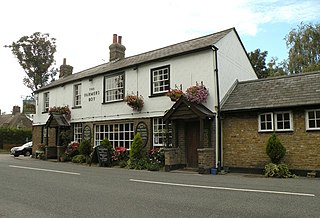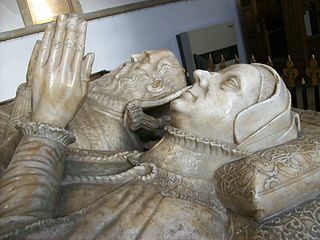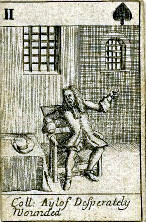
Hoddesdon is a town in the Borough of Broxbourne, Hertfordshire, lying entirely within the London Metropolitan Area and Greater London Urban Area. The area is on the River Lea and the Lee Navigation along with the New River.

The Rye House Plot of 1683 was a plan to assassinate King Charles II of England and his brother James, Duke of York. The royal party went from Westminster to Newmarket to see horse races and were expected to make the return journey on 1 April 1683, but because there was a major fire in Newmarket on 22 March, the races were cancelled, and the King and the Duke returned to London early. As a result, the planned attack never took place.

Sir Anthony Denny was Groom of the Stool to King Henry VIII of England, thus his closest courtier and confidant. In 1539 he was appointed a gentleman of the privy chamber and was its most prominent member in King Henry's last years, having together with his brother-in-law, John Gates, charge of the "dry stamp" of the King's signature, and attended the King on his deathbed. He was a member of the Reformist circle that offset the conservative religious influence of Bishop Gardiner. He was a wealthy man, having acquired several manors and former religious sites distributed by the Court of augmentations after the Dissolution of the Monasteries. By 1548, he was keeper of the Palace of Westminster.

Abbots Langley is a large village and civil parish in the English county of Hertfordshire. It is an old settlement and is mentioned in the Domesday Book. Economically the village is closely linked to Watford and was formerly part of the Watford Rural District. Since 1974 it has been included in the Three Rivers district.

Langleybury is a country house and estate in Abbots Langley, Hertfordshire, England, about 3 miles (5 km) northwest of the centre of the town of Watford. The house stands on a low hill above the valley of the River Gade.

Sir Henry Chauncy was an English lawyer, topographer and antiquarian. He is best known for his county history of Hertfordshire, published in 1700.
The High Sheriff of Hertfordshire was an ancient Sheriff title originating in the time of the Angles, not long after the foundation of the Kingdom of England, which was in existence for around a thousand years. On 1 April 1974, under the provisions of the Local Government Act 1972, the title of Sheriff of Hertfordshire was retitled High Sheriff of Hertfordshire. The High Shrievalties are the oldest secular titles under the Crown in England and Wales, their purpose being to represent the monarch at a local level, historically in the shires.
Rye House Stadium was a greyhound racing and speedway venue in Rye Road, Hoddesdon, Hertfordshire. It is situated adjacent to the River Lea Navigation.

Brickendon is a village in the civil parish of Brickendon Liberty in the district of East Hertfordshire about 3 miles (4.8 km) south of the county town Hertford, and is served by Bayford railway station.
Walter Hindes Godfrey, CBE, FSA, FRIBA (1881–1961), was an English architect, antiquary, and architectural and topographical historian. He was also a landscape architect and designer, and an accomplished draftsman and illustrator. He was (1941–60) the first director and the inspiration behind the foundation of the National Buildings Record, the basis of today's Historic England Archive, and edited or contributed to numerous volumes of the Survey of London. He devised a system of Service Heraldry for recording service in the European War.

Richard Rumbold (1622–1685) was a Parliamentarian soldier and political radical, exiled for his role in the 1683 Rye House Plot and later executed for taking part in the 1685 Argyll's Rising.

John Williams, 1st Baron Williams of Thame was Master of the Jewels and Lord President of the Council of the Welsh Marches. He was summoned to parliament as Lord Williams of Thame on 17 February 1554.

John Ayloffe was an English lawyer, political activist, and satirist, described as "one of the most consistently committed radicals of the century". According to his contemporary and political opponent Sir Roger L'Estrange, there were few 'more daring men for a desperate exploit'.
Thomas Gawdy, of Shotesham and Redenhall, Norfolk, was Serjeant-at-law, an English barrister, Recorder, and member of parliament.

William Paston, the only son of Clement Paston and Beatrice Somerton, had a distinguished career as a lawyer and Justice of the Common Pleas. He acquired considerable property, and is considered "the real founder of the Paston family fortunes".
John Paston I was an English country gentleman and landowner. He was the eldest son of the judge William Paston, Justice of the Common Pleas. After he succeeded his father in 1444, his life was marked by conflict occasioned by a power struggle in East Anglia between the dukes of Suffolk and Norfolk, and by his involvement in the affairs of his wife's kinsman, Sir John Fastolf. Between 1460–1466 he was Justice of the Peace for Norfolk, and was elected as a member of parliament in 1460 and again in 1461. A number of his letters survive among the Paston Letters, a rich source of historical information for the lives of the English gentry of the period.

Woodhall Park is a Grade I listed country house near Watton-at-Stone, Hertfordshire, England. The 18th century neo-classical building is set in a walled park in the Beane valley. It has been the home of Heath Mount School since the 1930s.
Maud Lane born Magdalen (Maud) Parr became Matilda or Maud, Lady Lane was an English courtier. She was the cousin of Katherine Parr and she became her courtier and supporter of the new Church of England religion.

Anne Say was an English Baroness through her marriage to Sir Henry Wentworth in c. 1470 until her death. She was the daughter of Sir John Say (1441–1483) and his wife Elizabeth Cheney, Lady Say. She is notable for being the maternal grandmother to Jane Seymour, the third wife of King Henry VIII of England, making her the great-grandmother to Edward VI.



















